In this blog, we will explore the profound impact of visual storytelling on web design and how it enhances user engagement, communicates brand narratives, and transforms the online experience.
1. Capturing Attention from the Start
In a world where users can swiftly navigate away from a webpage, capturing attention from the moment a visitor lands on your site is paramount. Visual storytelling, through strategically placed images, videos, and graphics, instantly engages users and encourages them to explore further. A compelling visual narrative sets the tone for the entire web experience.
2. Building Emotional Connections
Humans are wired to connect with stories on an emotional level. Visual storytelling in web design goes beyond presenting facts; it creates an emotional connection between the brand and the audience. Whether through impactful images or relatable narratives, emotions elicit a memorable response and strengthen the user’s bond with the brand.
3. Communicating Brand Identity
Visual storytelling serves as a powerful tool for communicating and reinforcing brand identity. Consistent visual elements, such as color schemes, imagery, and design styles, create a cohesive and recognizable brand presence. Through visuals, brands can convey their personality, values, and unique selling propositions, fostering a distinct and memorable identity.
4. Guiding the User Journey
Effective visual storytelling guides users through a seamless and intuitive journey on the website. Using visuals to structure information, such as through scroll-triggered animations, interactive elements, and visual cues, ensures that users navigate through the content effortlessly. The story unfolds as users progress, keeping them engaged at every step.
5. Enhancing User Experience
Visual storytelling contributes significantly to enhancing the overall user experience. Instead of presenting users with a wall of text, well-designed visuals break down information into digestible segments, making the content more accessible and enjoyable. This approach caters to different learning styles and preferences, resulting in a positive and user-friendly experience.
6. Differentiating from Competitors
In a competitive online landscape, standing out is essential. Visual storytelling provides a unique and creative avenue for differentiation. By crafting a narrative that sets a brand apart, web designers can create a memorable and distinctive user experience that lingers in the minds of visitors.
7. Increasing Retention and Recall
Studies show that people remember information better when it’s presented in a story format. Visual storytelling leverages this cognitive principle, making information more memorable. Users are more likely to retain and recall details about a brand or product when presented through a compelling visual narrative.
8. Boosting Engagement on Social Media
Visual stories are highly shareable, making them ideal for social media platforms. Integrating visual storytelling into web design not only enhances the on-site experience but also provides shareable content for social media channels. This extends the reach of the brand story and encourages social sharing and engagement.
9. Adapting to Mobile Consumption
As mobile usage continues to rise, web design must adapt to smaller screens and diverse user behaviors. Visual storytelling, with its emphasis on concise and impactful visuals, is well-suited for mobile consumption. Responsive design ensures a seamless visual narrative across various devices, catering to the growing mobile audience.
10. Measuring Impact and Iterating
The impact of visual storytelling can be measured through analytics. Monitoring user engagement, time spent on pages, and conversion rates provides valuable insights into the effectiveness of the visual narrative. Web designers can use this data to iterate and refine the storytelling approach for continuous improvement.
Conclusion
In the dynamic realm of web design, visual storytelling has emerged as a powerful tool that transcends traditional boundaries. It transforms websites into immersive experiences, allowing brands to connect with their audience on a deeper level. As technology evolves and user expectations shift, the impact of visual storytelling in web design will continue to shape the digital landscape, providing new opportunities for creativity, engagement, and brand expression. Web designers who harness the potential of visual storytelling are not just creating websites; they are crafting digital narratives that leave a lasting impression.

